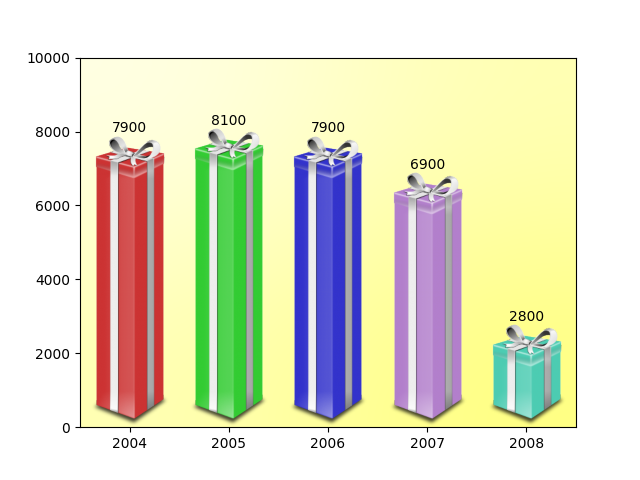Note
Click here to download the full example code
Ribbon Box#
import numpy as np
from matplotlib import cbook, colors as mcolors
from matplotlib.image import AxesImage
import matplotlib.pyplot as plt
from matplotlib.transforms import Bbox, TransformedBbox, BboxTransformTo
class RibbonBox:
original_image = plt.imread(
cbook.get_sample_data("Minduka_Present_Blue_Pack.png"))
cut_location = 70
b_and_h = original_image[:, :, 2:3]
color = original_image[:, :, 2:3] - original_image[:, :, 0:1]
alpha = original_image[:, :, 3:4]
nx = original_image.shape[1]
def __init__(self, color):
rgb = mcolors.to_rgba(color)[:3]
self.im = np.dstack(
[self.b_and_h - self.color * (1 - np.array(rgb)), self.alpha])
def get_stretched_image(self, stretch_factor):
stretch_factor = max(stretch_factor, 1)
ny, nx, nch = self.im.shape
ny2 = int(ny*stretch_factor)
return np.vstack(
[self.im[:self.cut_location],
np.broadcast_to(
self.im[self.cut_location], (ny2 - ny, nx, nch)),
self.im[self.cut_location:]])
class RibbonBoxImage(AxesImage):
zorder = 1
def __init__(self, ax, bbox, color, *, extent=(0, 1, 0, 1), **kwargs):
super().__init__(ax, extent=extent, **kwargs)
self._bbox = bbox
self._ribbonbox = RibbonBox(color)
self.set_transform(BboxTransformTo(bbox))
def draw(self, renderer, *args, **kwargs):
stretch_factor = self._bbox.height / self._bbox.width
ny = int(stretch_factor*self._ribbonbox.nx)
if self.get_array() is None or self.get_array().shape[0] != ny:
arr = self._ribbonbox.get_stretched_image(stretch_factor)
self.set_array(arr)
super().draw(renderer, *args, **kwargs)
def main():
fig, ax = plt.subplots()
years = np.arange(2004, 2009)
heights = [7900, 8100, 7900, 6900, 2800]
box_colors = [
(0.8, 0.2, 0.2),
(0.2, 0.8, 0.2),
(0.2, 0.2, 0.8),
(0.7, 0.5, 0.8),
(0.3, 0.8, 0.7),
]
for year, h, bc in zip(years, heights, box_colors):
bbox0 = Bbox.from_extents(year - 0.4, 0., year + 0.4, h)
bbox = TransformedBbox(bbox0, ax.transData)
ax.add_artist(RibbonBoxImage(ax, bbox, bc, interpolation="bicubic"))
ax.annotate(str(h), (year, h), va="bottom", ha="center")
ax.set_xlim(years[0] - 0.5, years[-1] + 0.5)
ax.set_ylim(0, 10000)
background_gradient = np.zeros((2, 2, 4))
background_gradient[:, :, :3] = [1, 1, 0]
background_gradient[:, :, 3] = [[0.1, 0.3], [0.3, 0.5]] # alpha channel
ax.imshow(background_gradient, interpolation="bicubic", zorder=0.1,
extent=(0, 1, 0, 1), transform=ax.transAxes, aspect="auto")
plt.show()
main()
Total running time of the script: ( 0 minutes 1.174 seconds)
